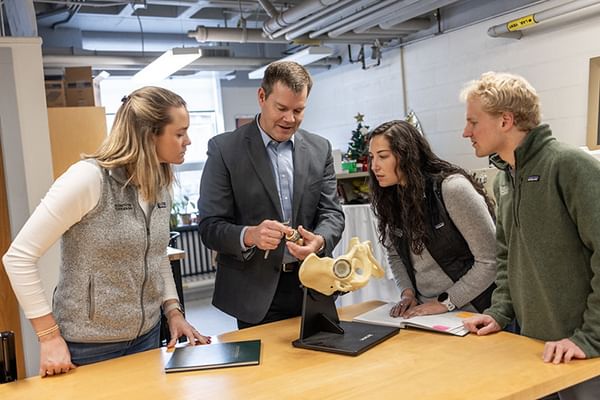- Undergraduate
Bachelor's Degrees
Bachelor of ArtsBachelor of EngineeringDual-Degree ProgramUndergraduate AdmissionsUndergraduate Experience
- Graduate
Graduate Experience
- Research
- Entrepreneurship
- Community
- About
-
Search

Douglas W. Van Citters
Interim Dean and Professor of Engineering
Adjunct Professor of Chemistry
Adjunct Professor of Orthopaedics

(Photo by Rob Strong '04)
Overview
Douglas Van Citters is interim dean and professor of engineering at Thayer School of Engineering at Dartmouth. A musculoskeletal scientist and expert on the materials, mechanics, and design of artificial joints, Van Citters brings decades of experience and a passionate commitment to Dartmouth Engineering's human-centered approach to education, research, and entrepreneurship. His lab, the Dartmouth Biomedical Engineering Center for Orthopaedics (DBEC), focuses on musculoskeletal biomaterials, biomechanics, tribology, and device design research and houses one of the largest IRB-approved retrieval programs in the world with over 23,000 artificial joints in its collection. His team holds over a dozen U.S. patents, with more pending. As a teacher-scholar, Van Citters has earned numerous recognitions, including the Woodhouse Excellence in Teaching Award in 2019 and the Outstanding Service Award for Faculty for his leadership during the COVID-19 pandemic in 2020.
Van Citters earned his bachelor of arts, bachelor of engineering, master of science, and PhD in engineering sciences from Dartmouth. He joined the Dartmouth faculty in 2007, and over the years, served in a variety of leadership roles at Thayer, including as the associate dean for undergraduate education. An advocate for interdisciplinary collaboration, Van Citters currently holds adjunct faculty appointments in chemistry and in orthopaedics and serves as biomaterials advisor in various departments within Dartmouth and at the Geisel School of Medicine.
Research Interests
Musculoskeletal Research, including: orthopaedic failure analysis and design; wear of polymers; polymer processing; biomaterials; biomechanics; implantable and wearable technology; surgical device design
Education
- AB, Engineering Sciences, Dartmouth 1999
- BE/MS, Engineering Sciences, Dartmouth 2003
- PhD, Engineering Sciences, Dartmouth 2006
Awards
- Outstanding Service Award for Faculty, Thayer School of Engineering, 2020
- Woodhouse Excellence in Teaching Award, Thayer School of Engineering, 2019
- Research Visiting Professor, Mayo Clinic Department of Orthopedic Surgery, 2018
- Thayer School Dean’s Mentoring Award, 2017
- ASME Journal of Tribology: Best Paper of 2007 Award, 2008
- The Dean's Service Award, Thayer School of Engineering, 2006
- The Charles F. and Ruth D. Goodrich Prize, Thayer School of Engineering, 2003
- The Myron Tribus Fellowship, 2003
- The Henry J. McCarthy 1931 Fellowship, 2001
Professional Activities
- Dartmouth College Faculty Athletics Representative
- Advisor for Tau Beta Pi student chapter
- Formula Hybrid Chief Engineering Examiner
- ASME Upper Valley Subsection Treasurer
- Member of ASME, ASEE, ORS, ASTM, Tau Beta Pi, Sigma Xi, ISTA, and AAOS
Research Projects
-
Oxidative Degradation of UHMWPE in Retrieved Shoulder and Knee Implants
Oxidative Degradation of UHMWPE in Retrieved Shoulder and Knee Implants
This project studies how ultra-high-molecular-weight polyethylene (UHMWPE) components in joint implants oxidize over time after implantation. By analyzing retrieved shoulder and knee implants, the research quantifies oxidation levels, correlates them with mechanical damage such as wear, delamination, or cracking, and evaluates how design, sterilization method, and in vivo duration affect material degradation and performance.
-
New devices for total joint arthroplasty
New devices for total joint arthroplasty
New devices research and developent for total joint arthroplasty includes:
- Testing of a new bi-material bearing for a total hip arthroplasty (THA) device against conventional bearing designs to compare levels of bearing surface damage and wear;
- Development of an intraoperative method for quantifying the orientation of prosthetic components used in total knee arthroplasty (TKA) that is efficient, easy to use, cost effective, and quick with respect to total surgical time.
See more about new devices.
-
New materials for orthopaedic implants
New materials for orthopaedic implants
New materials research and development for orthopaedic implants includes:
- Evaluation of equal channel angular extrusion (ECAE)-processed ultra-high molecular weight polyethylene (UHMWPE) for joint arthroplasty and industrial applications;
- Investigation of off-label use of a resorbable calcium sulfate antibiotic carrier in single stage and two-stage procedures to determine the potential of this use to change damage patterns or wear rates of artificial joints.
See more about new materials.
-
Biomechanics analysis and monitoring
Biomechanics analysis and monitoring
Biomechanics analysis and monitoring following joint arthroplasty is valuable for achieving optimal recovery. Our laboratory has developed and implemented a novel method for monitoring continuous long term joint function using inertial measurement units (IMUs). Prospective studies are in progress to compare knee and shoulder function before and after arthroplasty. This data can be compared to a cohort of healthy individuals with no known joint arthropathy.
See more about biomechanics.
-
Joint replacement bearing material behavior
Joint replacement bearing material behavior
Material behavior of medical grade ultra-high molecular weight polyethylene (UHMWPE) was identified as a serious concern as it limits the overall lifetime and success of a joint replacement. Although total joint arthroplasty involving UHMWPE as a bearing surface has been one of the most successful procedures of the last century, issues of wear, oxidation, and fatigue failure remain obstacles to the longevity of joint replacements.
See more about UHMWPE material behavior.
-
Knee/shoulder implant bearing function
Knee/shoulder implant bearing function
Bearing function of retrieved knee devices sent to us by orthopaedic surgeons are assessed for damage, and also quantitatively assessed for wear. Dimensions of retrievals are compared to design specifications or shorter in-vivo duration devices to calculate both articular and backside wear. Wear and wear rate are correlated with variables including polyethylene pedigree, articular bearing geometry, device fixation, and patient factors.
Current work also includes examination of a series of reverse and total shoulders to determine the incidence of abrasive and adhesive wear and determine typical locations for these wear patterns on polyethylene components.
See more about knee/shoulder implant bearing function.
-
Orthopaedic implant failure analysis
Orthopaedic implant failure analysis
Implant failure analysis in the Dartmouth Biomedical Engineering Center for Orthopaedics is ongoing and plays a key role in identifying failure modes and relating them to various designs and materials being used in the industry. In fact, in 2000, NIH's Consensus Development Program produced a technology assessment statement acknowledging the value of implant retrieval programs:
- Implant retrieval and analysis is of critical importance in the process of improving care of patients in need of implants.
- Attention needs to be directed toward reducing various obstacles to implant retrieval and analysis, particularly legal and economic disincentives.
- The failure to appreciate the value of implant retrieval and analysis is a serious impediment to research in devices. A focused educational program will provide the information necessary for improving the quality of future devices.
See more about implant failure analysis.
Selected Publications
- Currier BH, Jevsevar KC, Van Citters DW. (2023) "Oxidation in retrieved, never-irradiated UHMWPE bearings: What can we learn about in vivo oxidation?" Journal of Bone and Joint Surgery. 105(4): 293-301.
- Smith TR, Foley KT, Boruah S, Slotkin JR, Woodard E, Lazor JB, Cavaleri C, Brown MC, McDonough B, Hess B, Van Citters DW. (2022) "Use of adhesive cranial bone flap fixation without hardware to improve mechanical strength, resist cerebrospinal fluid leakage, and maintain anatomical alignment: a laboratory study." Journal of Neurosurgery. 139(2): 517-527.
- Favreau HJ, Miroshnichenko KI, Solberg PC, Tsukrov II, Van Citters DW. (2022) "Shear enhancement of mechanical and microstructural properties of synthetic graphite and ultra‐high molecular weight polyethylene carbon composites." Journal of Applied Polymer Science. 139(20), e52175.
- Currier JH, Currier BH, Abdel MP, Berry DJ, Titus A, Van Citters DW. (2021) "What factors drive polyethylene wear in total knee arthroplasty? Results of a large retrieval series." Bone and Joint Journal. 103(11).
- Vasylevskyi K, Tsukrov I, Miroshnichenko K, Buklovskyi S, Grover H, Van Citters DW. (2021) "Finite element model of equal channel angular extrusion of ultra high molecular weight polyethylene." Journal of Manufacturing Science and Engineering. 143(12).
- Kesseli FP, Lauer CS, Baker I, Mirica KA, Van Citters DW. (2020) "Identification of a calcium phosphoserine coordination network in an adhesive organo-apatitic bone cement system." Acta Biomaterialia. 105: 280-289.
- Seeley-Hacker BL, Holmgren EP, Harper CW, Lauer CS, Van Citters DW. (2020) "An anatomic predisposition to mandibular angle fractures." Journal of Oral and Maxillofacial Surgery. 78(12): 2279-e1.
- Chapman RM, Bell JE, Torchia M, Van Citters DW. (2019) "Continuously monitoring total shoulder arthroplasty rehabilitation: Maximum elevation & time spent above 90° elevation are critical metrics to monitor." Journal of Shoulder and Elbow Surgery. 2019 August; 28(8).
- Chapman RM, Moschetti WE, Van Citters DW. (2019) "Stance and swing phase knee flexion recover at different rates following total knee arthroplasty: An inertial measurement unit study." J. Biomechanics. 2019 Feb 14; V84.
- Currier BH, Hecht PJ, Nunley JA, Mayor MB, Currier JH, Van Citters DW. (2018) "Analysis of failed ankle arthroplasty components". Foot & Ankle International. 2018 Oct 8; 1071100718802589.
- Fung M, Bowsher JG, Van Citters DW. (2018) "Variation of mechanical properties and oxidation with radiation dose and source in highly crosslinked remelted UHMWPE". Journal of the Mechanical Behavior of Biomedical Materials. 2018(82): 112-9.
- Currier BH, Currier JH, Holdcroft LA, Van Citters DW. (2018) "Effectiveness of anti-oxidant polyethylene: What early retrievals can tell us." Journal of Biomedical Materials Research Part B: Applied Biomaterials. 2018; 106(1).
Patents
- Orthopedic leg alignment system and method | 11679007
- Bilateral humeral guide for intraosseous infusion | 11534558
- Orthopedic leg alignment system and method | 11419737
- Movement monitoring systems and methods | 11406290
- Device for enabling placement of intra-osseous infusion tools in the upper extremity | 11357546
- Method of enhancing interdigitation of bone cement to bone for attachment of prosthesis to bone during arthroplasty | 11324518
- Angular processing of polymer composites for electrically conducting polymers | 10829623
- Orthopedic leg alignment system and mechanism | 10828175
- Movement monitoring systems and methods | 10463279
- Method of enhancing interdigitation of bone cement to bone for attachment of prosthesis to bone | 10448958
- Angular extrusion for polymer consolidation | 8642723
Videos
Expanding Financial Aid for Dartmouth Engineering's BE Students
Undergraduate Info Session
Dartmouth Engineering: Solid Mechanics
Graduate Student Research: Orthopedic Biomaterials
Graduate Student Research: Corrosion of Biomaterials
Graduate Student Research: Orthopedic Materials
Graduate Student Research: Orthopedic Implants
Graduate Student Research: Orthopedic Biomaterials
PhD Innovation Program: Steven Reinitz
Why Get a Dartmouth PhD in Engineering
News





In the News
engineering.com
Engineering Faculty and Students Meet the Challenges of Remote Engineering Education
Feb 25, 2021
Engineering Faculty and Students Meet the Challenges of Remote Engineering Education
Feb 25, 2021
The Dartmouth
Fall classes to be mostly online due to equity concerns, logistical issues
Aug 03, 2020
Fall classes to be mostly online due to equity concerns, logistical issues
Aug 03, 2020


















